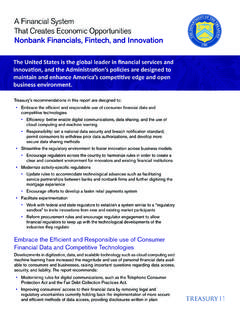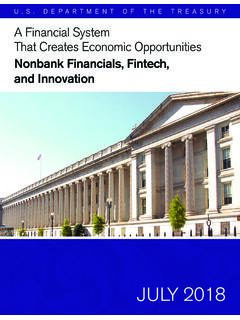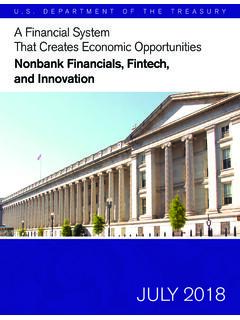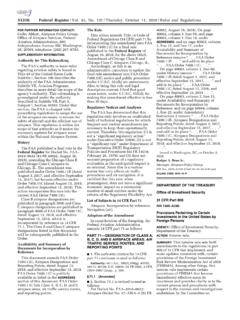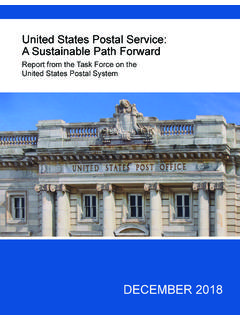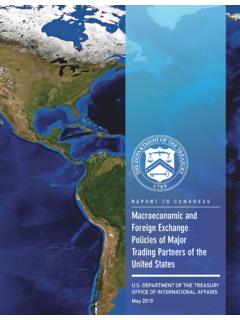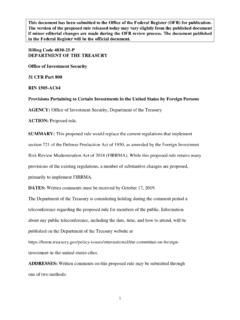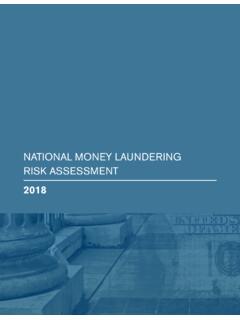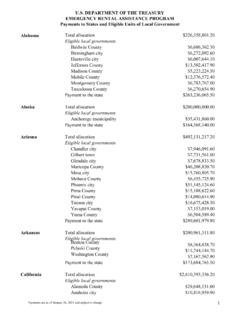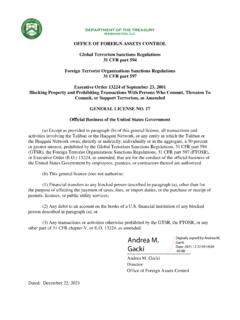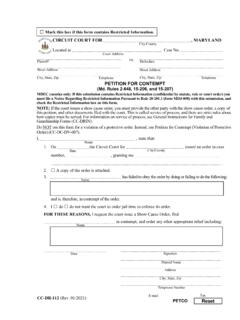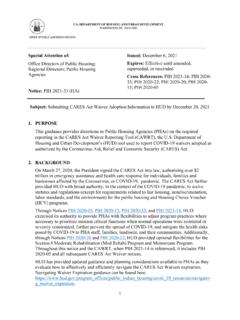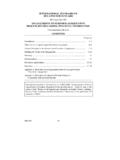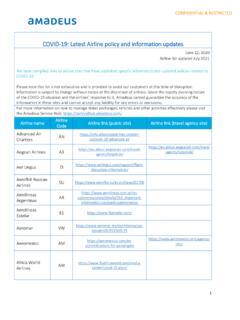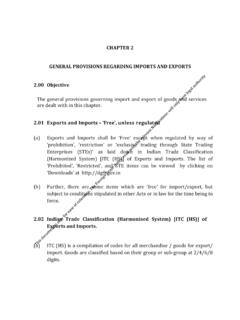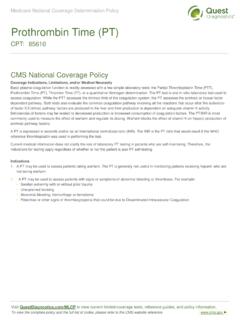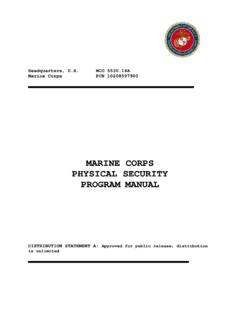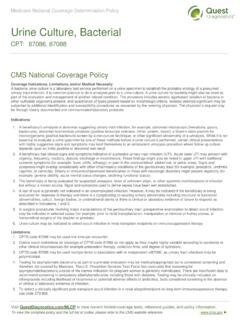Transcription of Coronavirus Relief Fund Revision to Guidance Regarding ...
1 Coronavirus Relief Fund Revision to Guidance Regarding When a Cost is Considered Incurred December 14, 2021 The Coronavirus Aid, Relief , and Economic Security Act (CARES) Act established the $150 billion Coronavirus Relief Fund (CRF). The CARES Act provides that payments from the CRF may only be used to cover costs that were incurred during the period that begins on March 1, 2020, and ends on December 31, 2021 (the covered period ).1 Treasury previously determined that, for a cost associated with the acquisition of a good or service or the acquisition of or improvement to real estate to be considered to have been incurred within the covered period, performance or delivery must have occurred during the covered period.
2 Although Treasury has considered the CRF to be a program designed for short-term needs of recipients to combat the virus and respond to the immediate effects of the pandemic, the public health emergency is still in effect, and state, local, and Tribal governments continue to be on the frontlines of the pandemic response. In addition, disruptions in supply chains have hindered recipients ability to obtain and put into use goods and equipment in a timely manner. These issues have been magnified in communities experiencing the Delta surge. Finally, given recent litigation, many recipients have not received their allocated payments from the CRF until the last few months.
3 In light of the foregoing, Treasury is now revising the Guidance to provide that a cost associated with a necessary expenditure incurred due to the public health emergency shall be considered to have been incurred by December 31, 2021, if the recipient has incurred an obligation with respect to such cost by December 31, 2021. Treasury defines obligation for this purpose consistently with the Uniform Guidance definition in 2 as an order placed for property and services and entry into contracts, subawards, and similar transactions that require payment.
4 Treasury s reporting framework currently permits recipients to record their expenditures through September 30, 2022. The CRF s eligible use is restricted to necessary expenditures incurred due to the COVID-19 public health emergency. Treasury currently expects that this expenditure deadline will provide a sufficient amount of time for recipients to expend their funds in accordance with the eligible uses of the CRF. Treasury has made certain adjustments to its frequently asked questions to reflect this Revision and will provide recipients subsequent updates as to how this change will be reflected in the CRF reporting requirements.
5 The remainder of Treasury s Guidance remains in effect. Consistent with Treasury s revised interpretation above, the text of the section of Treasury s Guidance under the heading Costs incurred during the period that begins on March 1, 2020, and 1 See section 601(d)(3) of the Social Security Act (42 801(d)(3)), as added by section 5001 of the CARES Act and as amended by section 1001 of Division N of the Consolidated Appropriations Act, 2021. 2 ends on December 31, 2021 has been revised. Treasury is also revising the answers to FAQs and to conform the responses to this new interpretation.
6 More information Questions Regarding the Coronavirus Relief Fund can be sent to Treasury s Guidance Regarding the use of funds is available here, subject to the revisions below: information about reporting and recordkeeping requirements related to CRF payments is available here: Revisions to Guidance The revised provisions of Treasury s Guidance are as follows: Costs incurred during the period that begins on March 1, 2020, and ends on December 31, 2021 The CARES Act provides that payments from the Fund may only be used to cover costs that were incurred during the period that begins on March 1, 2020, and ends on December 31, 2021 (the covered period ).
7 A cost associated with a necessary expenditure incurred due to the public health emergency is considered to have been incurred by December 31, 2021, if the recipient has incurred an obligation with respect to such cost by December 31, 2021. Treasury defines obligation for this purpose as an order placed for property and services and entry into contracts, subawards, and similar transactions that require payment. Recipients are required to expend their funds received from the CRF to cover these obligations by September 30, 2022. May Fund recipients upgrade critical public health infrastructure, such as providing access to running water for individuals and families in rural and tribal areas to allow them to maintain proper hygiene and defend themselves against the virus?
8 Yes, fund recipients may use payments from the Fund to upgrade public health infrastructure, such as providing individuals and families access to running water to help reduce the further spread of the virus. As required by the CARES Act, expenses associated with such upgrades must be incurred by December 31, 2021. Please see the discussion of the interpretation of incurred under the heading Costs incurred during the period that begins on March 1, 2020, and ends on December 31, 2021. 3 May payments from the Fund be used for real property acquisition and improvements and to purchase equipment to address the COVID-19 public health emergency?
9 The expenses of acquiring or improving real property and of acquiring equipment ( , vehicles) may be covered with payments from the Fund in certain cases. For example, Treasury s initial Guidance referenced coverage of the costs of establishing temporary public medical facilities and other measures to increase COVID-19 treatment capacity, including related construction costs, as an eligible use of funds. Any such use must be consistent with the requirements of section 601(d) of the Social Security Act as added by the CARES Act. As with all uses of payments from the Fund, the use of payments to acquire or improve property is limited to that which is necessary due to the COVID-19 public health emergency.
10 In the context of acquisitions of real estate and acquisitions of equipment, this means that the acquisition itself must be necessary. In particular, a government must (i) determine that it is not able to meet the need arising from the public health emergency in a cost-effective manner by leasing property or equipment or by improving property already owned and (ii) maintain documentation to support this determination. Likewise, an improvement, such as the installation of modifications to permit social distancing, would need to be determined to be necessary to address the COVID-19 public health emergency.
